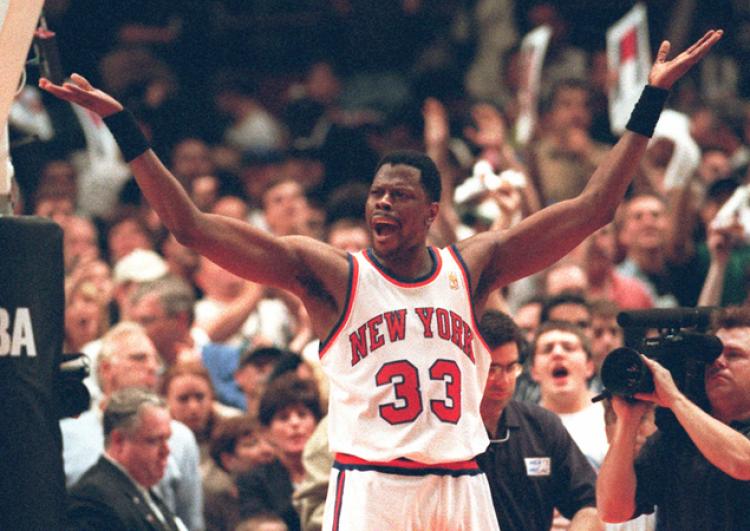In 2001, Bill Simmons penned a revolutionary article on a theory that unexpectedly comes to fruition in sports from time to time. This, of course, is the Ewing Theory, coined after former Georgetown and New York Knicks Hall of Fame Center, Patrick Ewing. (Click HERE to read the original article.) For those unfamiliar, we’ll reference it directly from the origin:
The theory was created in the mid-’90s by Dave Cirilli, a friend of mine (Simmons) who was convinced that Patrick Ewing’s teams (both at Georgetown and with New York) inexplicably played better when Ewing was either injured or missing extended stretches because of foul trouble.
The Ewing Theory firmly established itself during the 1999 NBA Finals, when Patrick Ewing, the best player for the Knicks in a generation, tore his Achilles in the Eastern Conference Finals. Left for dead, the Knickerbockers shocked the Indiana Pacers to book a ticket to the NBA Finals, where they eventually succumbed to Tim Duncan earning the first of several titles in his own Hall of Fame career.
According to Simmons and Cirilli, there are two crucial criteria that comprise the Ewing Theory
- A star athlete receives an inordinate amount of media attention and fan interest, and yet his teams never win anything substantial with him (other than maybe some early-round playoff series).
- That same athlete leaves his team (either by injury, trade, graduation, free agency or retirement) — and both the media and fans immediately write off the team for the following season.
Sounds familiar, doesn’t it? Although the Packers earned the 2010 title with Aaron Rodgers, they have piled up earlier than expected exits in the postseason ever since. Yes, they’ve made two conference championship appearances, and inexcusably choked away the 2014 matchup against the Seahawks. With a player of his caliber, in his prime, always contending, and now injured, the door for the Ewing Theory to sweep into Green Bay has been blown wide open.
Sit down and watch TV for an hour on any night, and you’re guaranteed to see a commercial with Aaron Rodgers in it, mostly likely the one where he’s joyriding in his Ford pickup with a dog. Sports Illustrated recently included him on their “A Nation Divided/Sports United” debacle of a cover. He is frequently linked to women familiar with the Hollywood scene. He boasts a significant social media presence. Aaron Rodgers is everywhere, and the media and fans eat it up. He fulfills criteria item #1 and then some.
Even more, he meets criteria item #2. The Packers were written off for 2017 before the last syllable of “broken collarbone” was formed. I stated publicly that I’d bet my house that the Packers are done.
In order for the Ewing Theory to apply, teammates of the Ewing candidate have to be complacent. They all feel comfortable when they suit up for their respective sports. Their comfort stems from the mindset that, “If this game is tight, our alpha dog will carry us through.” Kevin Garnett is famously quoted as saying his teammates can more or less do what they want for the first three quarters, but “come 4th quarter, bring it to the Ticket.” Aaron Rodgers is the Big Ticket. He is the Big Ticket that willed his Packers into a dramatic comeback against Dallas not even two weeks ago. Well Packers, Big Ticket is gone now. Shredded. Crumpled up. Tossed in the receptacle.
Ewing Theory teams turn things around through sheer will and urgency. Sometimes, they are downright panicked. The Packers have to be panicked right now. With football being the ultimate team sport, the defense needs to play panicked every minute the rest of the season. The offense needs to play panicked until they’re comfortable with what Brett Hundley has to offer, IF he begins to deliver. Putting that as a big IF is an understatement at this moment. Ultimately, it is the urgency that drives the unexpected success of a Ewing Theory roster. The things humans can accomplish when put into precarious situations can be miraculous at times. Not that a sport should be compared to a fight-or-flight situation one can face in the real world, but athletes are in situations of high intensity and motivation enough that they sometimes pull off the improbable.
The ’99 Knicks picked up the slack and played a championship series like their hair was on fire. Other Ewing Theory teams that Bill Simmons mentioned in his article unexpectedly thrived after the faces of their franchises were gone. The Seattle Mariners, which he references, fired off multiple playoff seasons after losing Randy Johnson, Ken Griffey Jr. and Alex Rodriguez. These are three of the best baseball players ever. Not best from the 90s or early 2000s. Ever. The Mariners had just as much postseason success immediately after these three left as they had when they were on the roster together. All logic at the time suggested they’d be a doormat for awhile after shedding all that talent.
The only hope for the Packers is the Ewing Theory. Brett Hundley stands to earn tens of millions of dollars off the Ewing Theory. You know he’ll bring it. And if he doesn’t have it, then we’ll all find out. As for the defensive side, someone needs to tap their inner Larry Johnson or Latrell Sprewell and will the defense to a standard that hasn’t been seen in nearly a decade.
Please make a visit to the Bay, Ewing Theory. You would go down in history.
________________
John Piotrowski is a UW-Eau Claire alum, spending most of his life in western WI. He makes the trek east to Lambeau whenever possible. Follow him on twitter at @piosGBP.
________________

